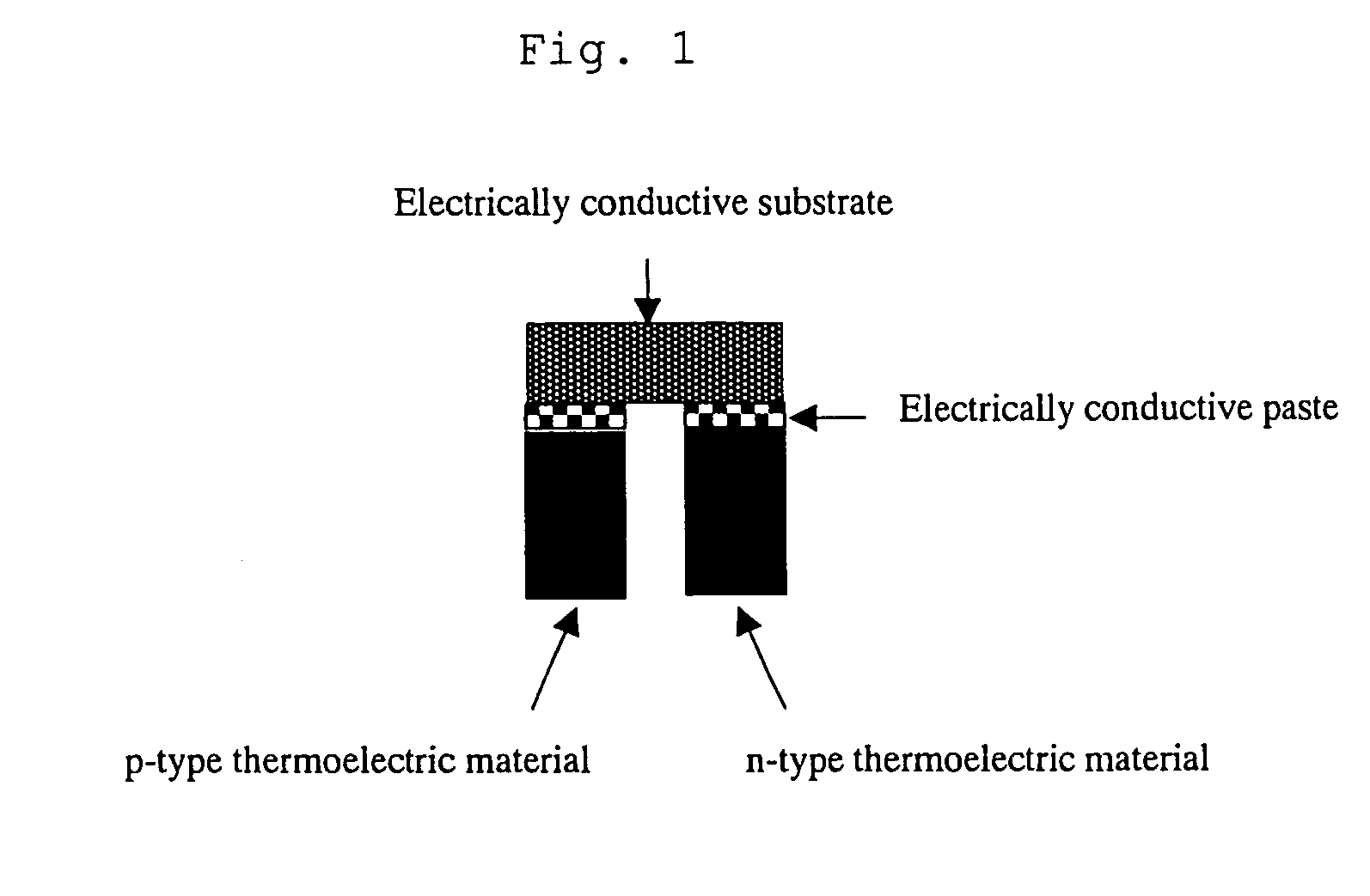Conductive paste for connecting thermoelectric conversion material
- Summary
- Abstract
- Description
- Claims
- Application Information
AI Technical Summary
Benefits of technology
Problems solved by technology
Method used
Image
Examples
example 1
Production of P-Type Thermoelectric Material
[0164] A p-type thermoelectric material represented by the formula Ca2.7Bi0.3Co4O9.2 was produced according to the following method.
[0165] Initially, calcium carbonate (CaCO3), bismuth oxide (Bi2O3), and cobalt oxide (Co3O4) were weighed out in such a manner as to yield a Ca:Bi:Co ratio (atomic ratio) of 2.7:0.3:4 and thoroughly mixed. The mixture was placed into an alumina crucible and calcined in air at 1073 K(800° C.) for 10 hours. The calcinate was sufficiently mixed using an agate mortar and pestle.
[0166] The obtained powder was molded by pressing into a disk-like form with a diameter of 20 mm and thickness of about 2 mm to about 10 mm. The molded body was placed on a gold sheet laid on an alumina boat, and sintered in a 300 ml / minute oxygen stream at 1153 k (880° C.) for 20 hours. The sintered body thus obtained was crushed using an agate mortar and pestle.
[0167] The powder thus obtained was molded by pressing into a plate-like ...
examples 2 to 94
[0189] Thermoelectric elements were produced in the same manner as in Example 1 except that the materials represented by the formulae in Tables 1 to 7 were used as oxide powder(s) to be mixed in the electrically conductive pastes for connecting p-type thermoelectric materials; oxide powder to be mixed in the electrically conductive pastes for connecting n-type thermoelectric materials; p-type thermoelectric materials; and n-type thermoelectric materials. The thermoelectric performance of the thermoelectric elements obtained was evaluated. In each Table, the amount of oxide powder to be mixed in the electrically conductive paste is expressed in parts by weight per 100 parts by weight of silver powder.
[0190] Each Table shows open-circuit voltages measured when the temperatures of the high-temperature portion and the low temperature portion were 973 K and 500 K, respectively, and inner resistances measured when the temperature of the high-temperature portion was 973K. The thermoelectr...
examples 95 to 106
[0197] Oxide powders represented by the formulae shown in Table 8 were used as oxide powders to be mixed in electrically conductive pastes for connecting p-type thermoelectric materials and electrically conductive pastes for connecting n-type thermoelectric materials. These oxide powders were mixed in a commercially-available gold paste (trade name: Au-4460, manufactured by Shoei Chemical Inc.), preparing electrically conductive pastes. The amount of oxide powder in each paste per 100 parts by weight of gold is shown in Table 8. The materials represented by the formulae shown in Table 8 were used as p-type thermoelectric materials and n-type thermoelectric materials.
[0198] Used was a gold paste comprising 85% by weight of gold powder (particle diameter of about 0.1 μm to about 5 μm), 1% by weight of borosilicate bismuth glass, 5% by weight of ethyl cellulose, 4% by weight of terpineol, and 5% by weight of butylcarbitol acetate. The amount of oxide powder was 6.25 parts by weight pe...
PUM
 Login to View More
Login to View More Abstract
Description
Claims
Application Information
 Login to View More
Login to View More - R&D
- Intellectual Property
- Life Sciences
- Materials
- Tech Scout
- Unparalleled Data Quality
- Higher Quality Content
- 60% Fewer Hallucinations
Browse by: Latest US Patents, China's latest patents, Technical Efficacy Thesaurus, Application Domain, Technology Topic, Popular Technical Reports.
© 2025 PatSnap. All rights reserved.Legal|Privacy policy|Modern Slavery Act Transparency Statement|Sitemap|About US| Contact US: help@patsnap.com



